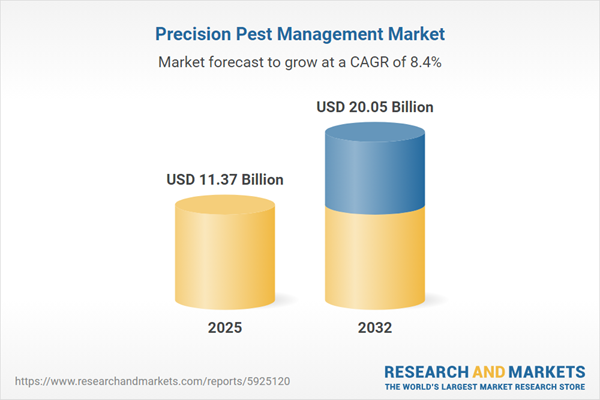Speak directly to the analyst to clarify any post sales queries you may have.
Precision pest management empowers organizations to strengthen compliance, secure operational reliability, and protect valuable assets in agriculture, infrastructure, and commercial settings. Senior decision-makers navigating regulatory demands are adopting digital solutions to enhance risk management and future-proof their operations.
Market Snapshot: Growth and Trends in the Precision Pest Management Market
The precision pest management market reached USD 10.49 billion in 2024 and is set to grow to USD 11.37 billion by 2025, representing a compound annual growth rate of 8.43%. This rise highlights the market’s shift toward automated digital monitoring, compliance-oriented operations, and sustainable approaches. Senior leadership is focusing on advanced analytics and automation, streamlining regulatory reporting and supporting real-time response. Digital platforms extend organizations' ability to detect threats, manage site-specific interventions, and establish scalable, efficient pest management practices within complex regulatory environments.
Scope & Segmentation of the Precision Pest Management Market
- Pest Types: Solutions target insect pests—such as Coleoptera, Diptera, Hemiptera, and Lepidoptera—alongside fungal pathogens, nematodes, rodents, and invasive weeds. Covering multiple pest risks, organizations secure compliance and resilience in both agricultural settings and urban infrastructure.
- Treatment Types: Portfolios span biological controls, pheromone-based interventions, botanical and microbial agents, targeted chemical solutions, mechanical measures, and cultural practices. This breadth enables adaptation to evolving regulatory standards and fosters operational flexibility.
- Crop Types: Market offerings serve cereal grains, fruits, vegetables, oilseeds, pulses, turf areas, and ornamentals. Addressing this range ensures effective pest management strategies for both high-yield agriculture and public space maintenance.
- Application Modes: Organizations deploy foliar sprays, soil and seed treatments, trunk injections, and fumigation to support proactive and reactive approaches. These diverse options tailor protective measures to various operational requirements.
- End Users: Commercial growers, utility managers, infrastructure operators, and residential organizations lead adoption by integrating compliance-focused, resource-efficient pest management into existing operations.
- Technologies: Robotics, autonomous drones, sensor networks (IoT), cloud-based analytics, and precision delivery systems support real-time monitoring, intervention automation, and data-driven asset management.
- Geographies: Adoption is accelerating worldwide, including the Americas, Europe, Middle East, Africa, and Asia-Pacific. Regions such as China, India, Japan, and Southeast Asia present additional compliance complexity, requiring location-specific digital strategies and robust regulatory alignment.
- Leading Companies Covered: Sector leaders include Rentokil Initial plc, Terminix Global Holdings, Rollins, Ecolab, and Anticimex AB, all advancing integrated, technology-driven pest management services.
Key Takeaways for Senior Decision-Makers
- Integrating digital oversight and predictive analytics enables rapid risk identification, proactive issue management, and enhanced scenario planning.
- Combining sustainable biological and cultural controls with established practices supports transparent operations, meeting evolving stakeholder and regulatory expectations.
- Collaborations between technology providers, service specialists, and producers allow quicker adaptation to regulatory updates and shifting client demands.
- Progress toward sustainability is accelerated by automated solutions and advanced management frameworks, minimizing dependence on traditional chemical treatments.
- Cohesive workforce training initiatives help embed new technologies, uphold asset protection, and reduce downtime during operational transitions.
- Flexible, modular platform designs future-proof compliance and procurement strategies as policy frameworks and market requirements adapt.
Tariff Impact on Supply Chain and Strategic Sourcing
Recent U.S. tariff adjustments have raised procurement costs for critical system components, increasing the importance of scalable and agile supply chains. To limit operational risk, organizations are diversifying suppliers, investing in modular equipment, and establishing regionally-focused vendor relationships that safeguard continuity and minimize disruption.
Methodology & Data Sources
This report is based on a structured mix of executive interviews, regulatory analysis, operational insight, contributions from authoritative publications, academic studies, and scenario modeling. The multidimensional approach validates findings and provides actionable guidance tailored for leadership teams assessing precision pest management strategies.
Why This Report Matters for Leadership Teams
- Clarifies complex regulatory environments by mapping digital, analytic, and operational trends, helping leaders make informed risk management decisions.
- Presents benchmarks and best practices for technology adoption, supporting strategic sustainability objectives and compliance obligations.
- Equips leadership to anticipate market shifts, respond to regulatory or sourcing changes proactively, and enhance organizational resilience in a dynamic sector landscape.
Conclusion
This report equips senior executives with clear guidance to navigate shifting regulations, advance sustainability initiatives, and ensure effective transitions within the precision pest management sector.
Additional Product Information:
- Purchase of this report includes 1 year online access with quarterly updates.
- This report can be updated on request. Please contact our Customer Experience team using the Ask a Question widget on our website.
Table of Contents
3. Executive Summary
4. Market Overview
7. Cumulative Impact of Artificial Intelligence 2025
Companies Mentioned
The companies profiled in this Precision Pest Management market report include:- Rentokil Initial plc
- Terminix Global Holdings, Inc.
- Rollins, Inc.
- Ecolab Inc.
- Anticimex AB
Table Information
| Report Attribute | Details |
|---|---|
| No. of Pages | 185 |
| Published | October 2025 |
| Forecast Period | 2025 - 2032 |
| Estimated Market Value ( USD | $ 11.37 Billion |
| Forecasted Market Value ( USD | $ 20.05 Billion |
| Compound Annual Growth Rate | 8.4% |
| Regions Covered | Global |
| No. of Companies Mentioned | 6 |









